Introductory Finance and Accounting TCA Answer Book –ACC10032122 1st Examination Module Number
VerifiedAdded on 2023/06/14
|10
|1725
|78
AI Summary
This TCA answer book covers the module title, total number of questions attempted, and student number for the Introductory Finance and Accounting course with code ACC10032122. It includes a cash flow statement, income statement, and statement of financial statement for a proposed business model. The book also discusses the decision-making process for a company considering the production of a product line and the factors that should be considered. The net profit margin and current ratio of the company are also analyzed.
Contribute Materials
Your contribution can guide someone’s learning journey. Share your
documents today.
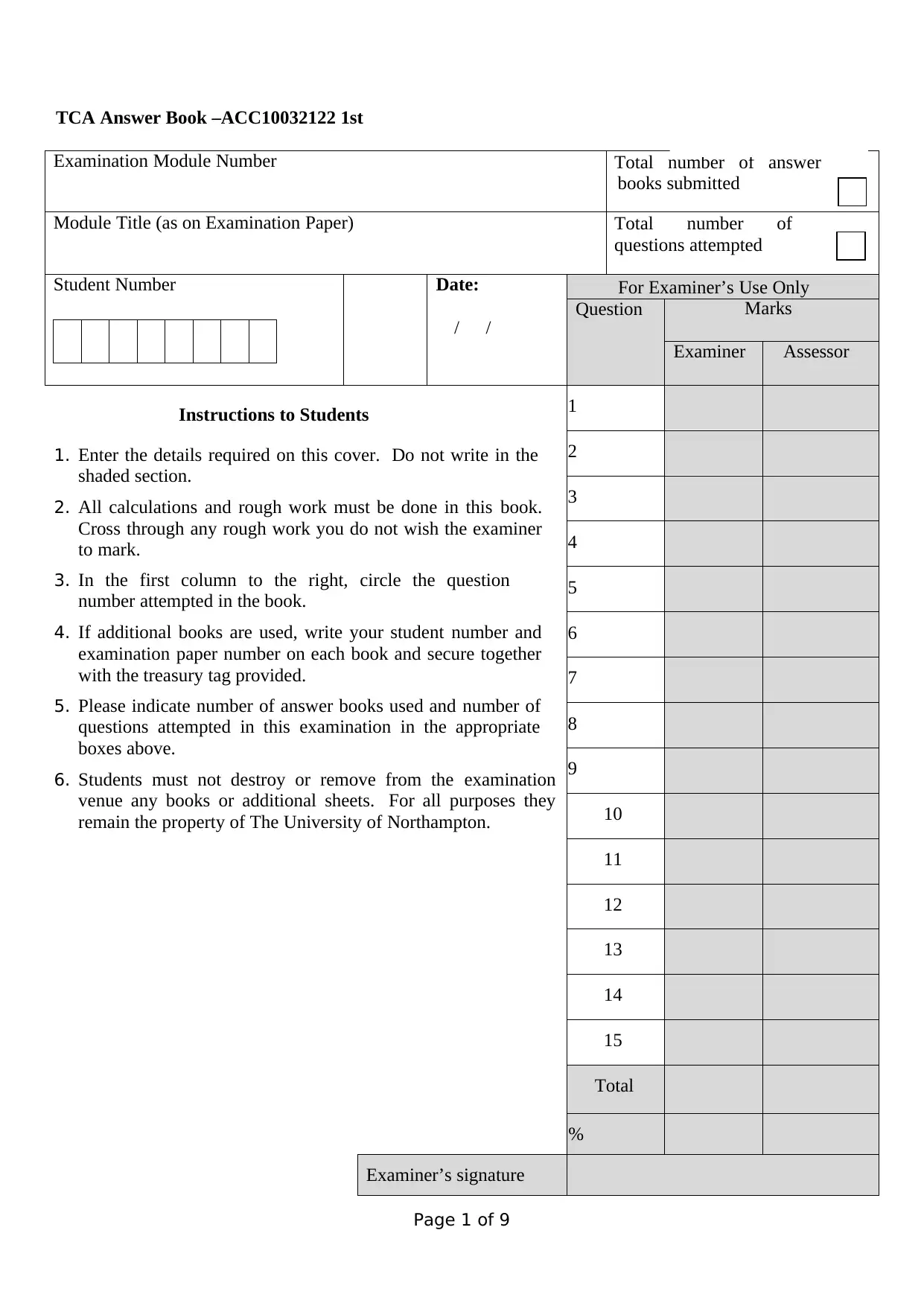
Page 1 of 9
TCA Answer Book –ACC10032122 1st
Examination Module Number Total number of answer
books submitted
Module Title (as on Examination Paper) Total number of
questions attempted
Student Number Date:
/ /
For Examiner’s Use Only
Question Marks
Examiner Assessor
Instructions to Students
1. Enter the details required on this cover. Do not write in the
shaded section.
2. All calculations and rough work must be done in this book.
Cross through any rough work you do not wish the examiner
to mark.
3. In the first column to the right, circle the question
number attempted in the book.
4. If additional books are used, write your student number and
examination paper number on each book and secure together
with the treasury tag provided.
5. Please indicate number of answer books used and number of
questions attempted in this examination in the appropriate
boxes above.
6. Students must not destroy or remove from the examination
venue any books or additional sheets. For all purposes they
remain the property of The University of Northampton.
1
2
3
4
5
6
7
8
9
10
11
12
13
14
15
Total
%
Examiner’s signature
TCA Answer Book –ACC10032122 1st
Examination Module Number Total number of answer
books submitted
Module Title (as on Examination Paper) Total number of
questions attempted
Student Number Date:
/ /
For Examiner’s Use Only
Question Marks
Examiner Assessor
Instructions to Students
1. Enter the details required on this cover. Do not write in the
shaded section.
2. All calculations and rough work must be done in this book.
Cross through any rough work you do not wish the examiner
to mark.
3. In the first column to the right, circle the question
number attempted in the book.
4. If additional books are used, write your student number and
examination paper number on each book and secure together
with the treasury tag provided.
5. Please indicate number of answer books used and number of
questions attempted in this examination in the appropriate
boxes above.
6. Students must not destroy or remove from the examination
venue any books or additional sheets. For all purposes they
remain the property of The University of Northampton.
1
2
3
4
5
6
7
8
9
10
11
12
13
14
15
Total
%
Examiner’s signature
Secure Best Marks with AI Grader
Need help grading? Try our AI Grader for instant feedback on your assignments.
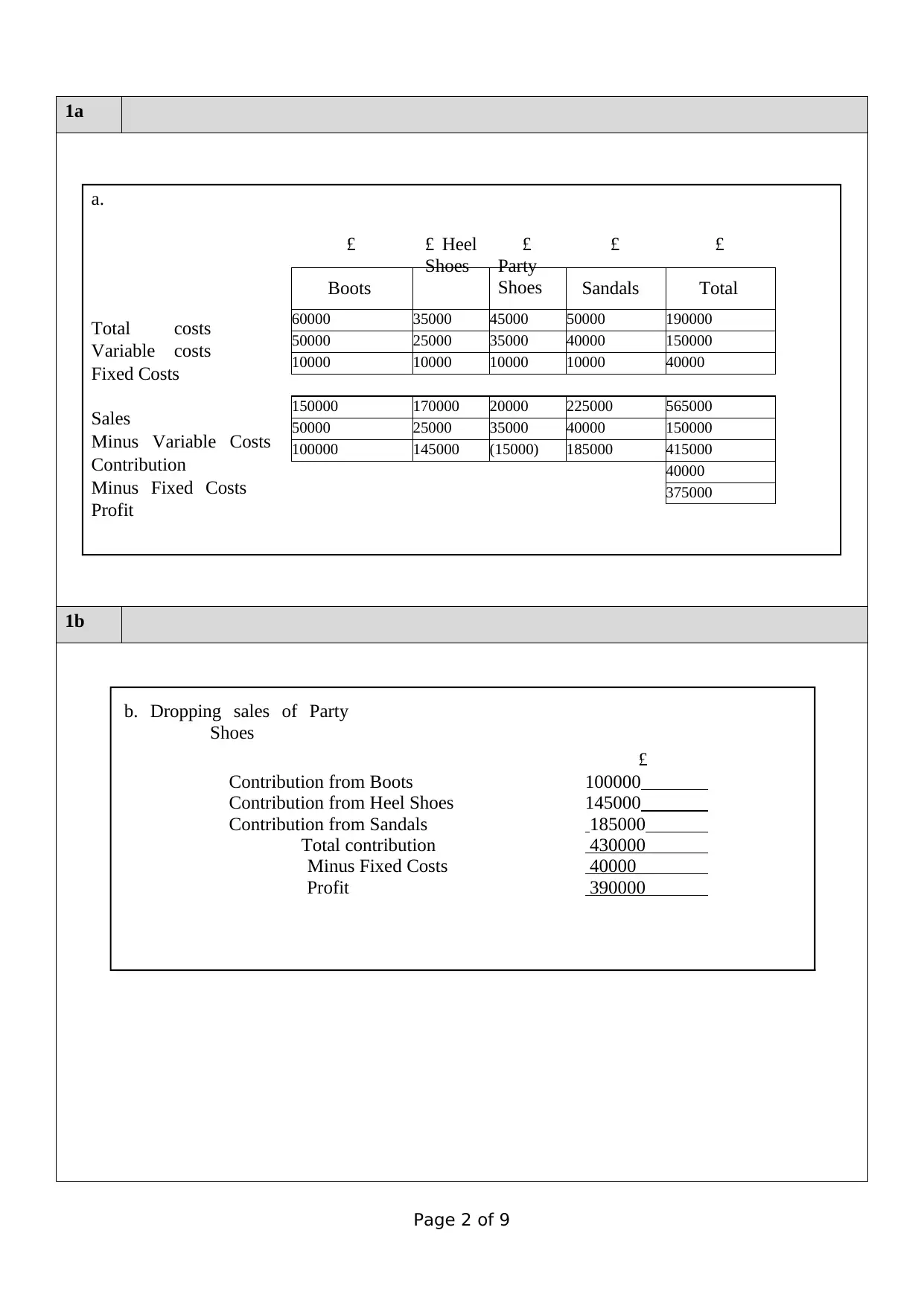
Page 2 of 9
1a
a.
Total costs
Variable costs
Fixed Costs
Sales
Minus Variable Costs
Contribution
Minus Fixed Costs
Profit
£
Boots
£ Heel
Shoes
£
Party
Shoes
£
Sandals
£
Total
1b
b. Dropping sales of Party
Shoes
£
Contribution from Boots 100000
Contribution from Heel Shoes 145000
Contribution from Sandals 185000
Total contribution 430000
Minus Fixed Costs 40000
Profit 390000
60000 35000 45000 50000 190000
50000 25000 35000 40000 150000
10000 10000 10000 10000 40000
150000 170000 20000 225000 565000
50000 25000 35000 40000 150000
100000 145000 (15000) 185000 415000
40000
375000
1a
a.
Total costs
Variable costs
Fixed Costs
Sales
Minus Variable Costs
Contribution
Minus Fixed Costs
Profit
£
Boots
£ Heel
Shoes
£
Party
Shoes
£
Sandals
£
Total
1b
b. Dropping sales of Party
Shoes
£
Contribution from Boots 100000
Contribution from Heel Shoes 145000
Contribution from Sandals 185000
Total contribution 430000
Minus Fixed Costs 40000
Profit 390000
60000 35000 45000 50000 190000
50000 25000 35000 40000 150000
10000 10000 10000 10000 40000
150000 170000 20000 225000 565000
50000 25000 35000 40000 150000
100000 145000 (15000) 185000 415000
40000
375000
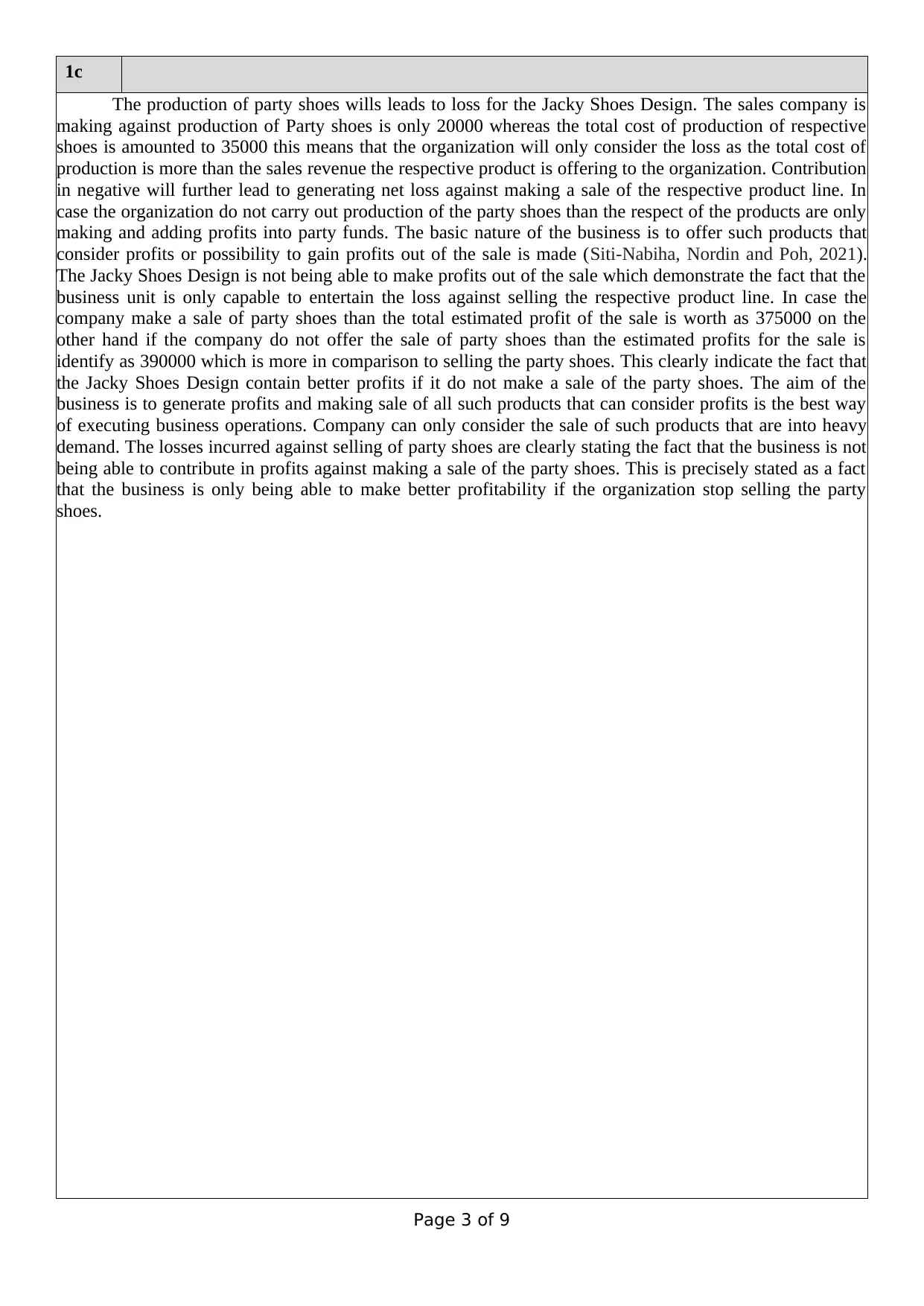
Page 3 of 9
1c
The production of party shoes wills leads to loss for the Jacky Shoes Design. The sales company is
making against production of Party shoes is only 20000 whereas the total cost of production of respective
shoes is amounted to 35000 this means that the organization will only consider the loss as the total cost of
production is more than the sales revenue the respective product is offering to the organization. Contribution
in negative will further lead to generating net loss against making a sale of the respective product line. In
case the organization do not carry out production of the party shoes than the respect of the products are only
making and adding profits into party funds. The basic nature of the business is to offer such products that
consider profits or possibility to gain profits out of the sale is made (Siti-Nabiha, Nordin and Poh, 2021).
The Jacky Shoes Design is not being able to make profits out of the sale which demonstrate the fact that the
business unit is only capable to entertain the loss against selling the respective product line. In case the
company make a sale of party shoes than the total estimated profit of the sale is worth as 375000 on the
other hand if the company do not offer the sale of party shoes than the estimated profits for the sale is
identify as 390000 which is more in comparison to selling the party shoes. This clearly indicate the fact that
the Jacky Shoes Design contain better profits if it do not make a sale of the party shoes. The aim of the
business is to generate profits and making sale of all such products that can consider profits is the best way
of executing business operations. Company can only consider the sale of such products that are into heavy
demand. The losses incurred against selling of party shoes are clearly stating the fact that the business is not
being able to contribute in profits against making a sale of the party shoes. This is precisely stated as a fact
that the business is only being able to make better profitability if the organization stop selling the party
shoes.
1c
The production of party shoes wills leads to loss for the Jacky Shoes Design. The sales company is
making against production of Party shoes is only 20000 whereas the total cost of production of respective
shoes is amounted to 35000 this means that the organization will only consider the loss as the total cost of
production is more than the sales revenue the respective product is offering to the organization. Contribution
in negative will further lead to generating net loss against making a sale of the respective product line. In
case the organization do not carry out production of the party shoes than the respect of the products are only
making and adding profits into party funds. The basic nature of the business is to offer such products that
consider profits or possibility to gain profits out of the sale is made (Siti-Nabiha, Nordin and Poh, 2021).
The Jacky Shoes Design is not being able to make profits out of the sale which demonstrate the fact that the
business unit is only capable to entertain the loss against selling the respective product line. In case the
company make a sale of party shoes than the total estimated profit of the sale is worth as 375000 on the
other hand if the company do not offer the sale of party shoes than the estimated profits for the sale is
identify as 390000 which is more in comparison to selling the party shoes. This clearly indicate the fact that
the Jacky Shoes Design contain better profits if it do not make a sale of the party shoes. The aim of the
business is to generate profits and making sale of all such products that can consider profits is the best way
of executing business operations. Company can only consider the sale of such products that are into heavy
demand. The losses incurred against selling of party shoes are clearly stating the fact that the business is not
being able to contribute in profits against making a sale of the party shoes. This is precisely stated as a fact
that the business is only being able to make better profitability if the organization stop selling the party
shoes.
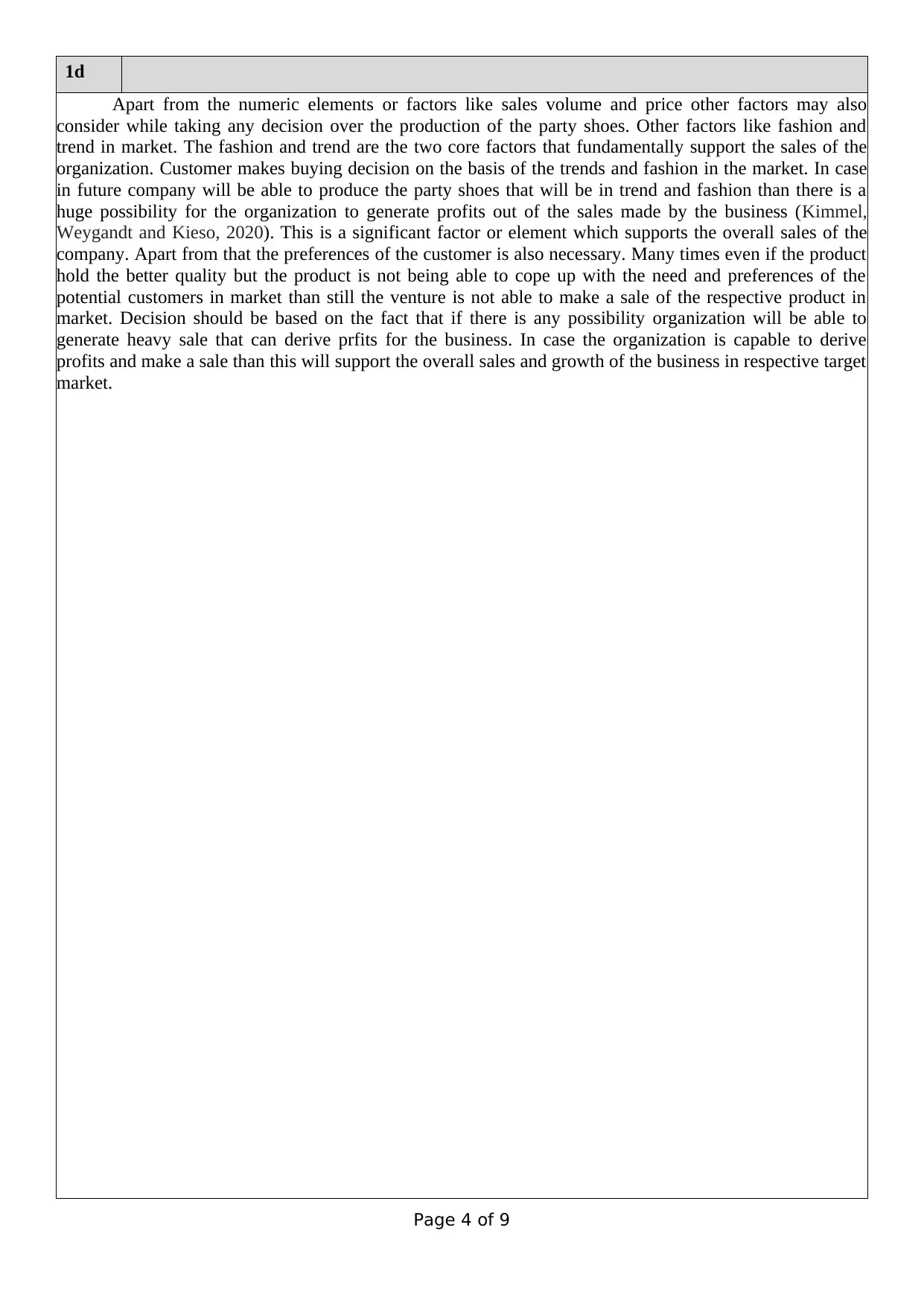
Page 4 of 9
1d
Apart from the numeric elements or factors like sales volume and price other factors may also
consider while taking any decision over the production of the party shoes. Other factors like fashion and
trend in market. The fashion and trend are the two core factors that fundamentally support the sales of the
organization. Customer makes buying decision on the basis of the trends and fashion in the market. In case
in future company will be able to produce the party shoes that will be in trend and fashion than there is a
huge possibility for the organization to generate profits out of the sales made by the business (Kimmel,
Weygandt and Kieso, 2020). This is a significant factor or element which supports the overall sales of the
company. Apart from that the preferences of the customer is also necessary. Many times even if the product
hold the better quality but the product is not being able to cope up with the need and preferences of the
potential customers in market than still the venture is not able to make a sale of the respective product in
market. Decision should be based on the fact that if there is any possibility organization will be able to
generate heavy sale that can derive prfits for the business. In case the organization is capable to derive
profits and make a sale than this will support the overall sales and growth of the business in respective target
market.
1d
Apart from the numeric elements or factors like sales volume and price other factors may also
consider while taking any decision over the production of the party shoes. Other factors like fashion and
trend in market. The fashion and trend are the two core factors that fundamentally support the sales of the
organization. Customer makes buying decision on the basis of the trends and fashion in the market. In case
in future company will be able to produce the party shoes that will be in trend and fashion than there is a
huge possibility for the organization to generate profits out of the sales made by the business (Kimmel,
Weygandt and Kieso, 2020). This is a significant factor or element which supports the overall sales of the
company. Apart from that the preferences of the customer is also necessary. Many times even if the product
hold the better quality but the product is not being able to cope up with the need and preferences of the
potential customers in market than still the venture is not able to make a sale of the respective product in
market. Decision should be based on the fact that if there is any possibility organization will be able to
generate heavy sale that can derive prfits for the business. In case the organization is capable to derive
profits and make a sale than this will support the overall sales and growth of the business in respective target
market.
Secure Best Marks with AI Grader
Need help grading? Try our AI Grader for instant feedback on your assignments.

Page 5 of 9
2a
a. Title? Cash flow statement
Month? Apr
£
Cash in
Capital Cash
sales Credit
sales Total
in
May June July Aug Sep Oct
£ £ £ £ £ £
Cash out
Fittings
Wages
Rent Other
Drawings
Purchases
Total out
Net Cash
flow
Balances
Opening
Closing
100000
50000 110000 150000 90000 120000 280000 300000
50000 60000 90000 140000 260000 300000 0
150000 170000 240000 230000 380000 580000 300000
80000
15000 15000 15000 15000 15000 15000 15000
2500 2500 2500 2500 2500 2500 2500
25000 25000 25000 25000 25000 25000 25000
600 600 600 600 600 600 600
0 50000 60000 90000 140000 130000 150000
145600 93100 103100 133100 183100 173100 193100
4400 76900 136900 96900 196900 406900 106900
0 4400 81300 218200 315100 512000
4400 81300 218200 315100 512000 918900
2a
a. Title? Cash flow statement
Month? Apr
£
Cash in
Capital Cash
sales Credit
sales Total
in
May June July Aug Sep Oct
£ £ £ £ £ £
Cash out
Fittings
Wages
Rent Other
Drawings
Purchases
Total out
Net Cash
flow
Balances
Opening
Closing
100000
50000 110000 150000 90000 120000 280000 300000
50000 60000 90000 140000 260000 300000 0
150000 170000 240000 230000 380000 580000 300000
80000
15000 15000 15000 15000 15000 15000 15000
2500 2500 2500 2500 2500 2500 2500
25000 25000 25000 25000 25000 25000 25000
600 600 600 600 600 600 600
0 50000 60000 90000 140000 130000 150000
145600 93100 103100 133100 183100 173100 193100
4400 76900 136900 96900 196900 406900 106900
0 4400 81300 218200 315100 512000
4400 81300 218200 315100 512000 918900
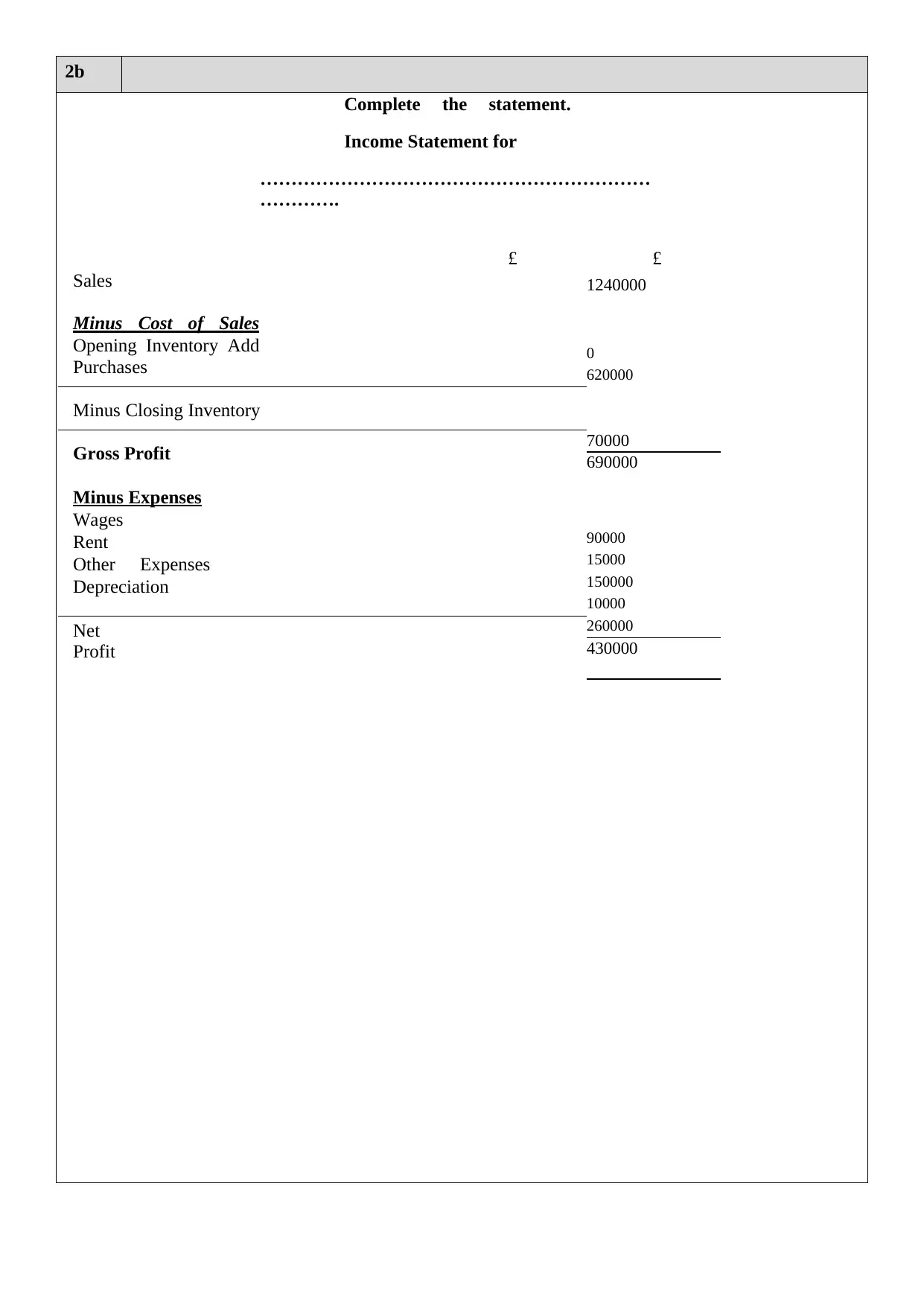
2b
Complete the statement.
Income Statement for
………………………………………………………
………….
£ £
Sales
Minus Cost of Sales
Opening Inventory Add
Purchases
Minus Closing Inventory
Gross Profit
Minus Expenses
Wages
Rent
Other Expenses
Depreciation
Net
Profit
1240000
0
620000
70000
690000
90000
15000
150000
10000
260000
430000
Complete the statement.
Income Statement for
………………………………………………………
………….
£ £
Sales
Minus Cost of Sales
Opening Inventory Add
Purchases
Minus Closing Inventory
Gross Profit
Minus Expenses
Wages
Rent
Other Expenses
Depreciation
Net
Profit
1240000
0
620000
70000
690000
90000
15000
150000
10000
260000
430000
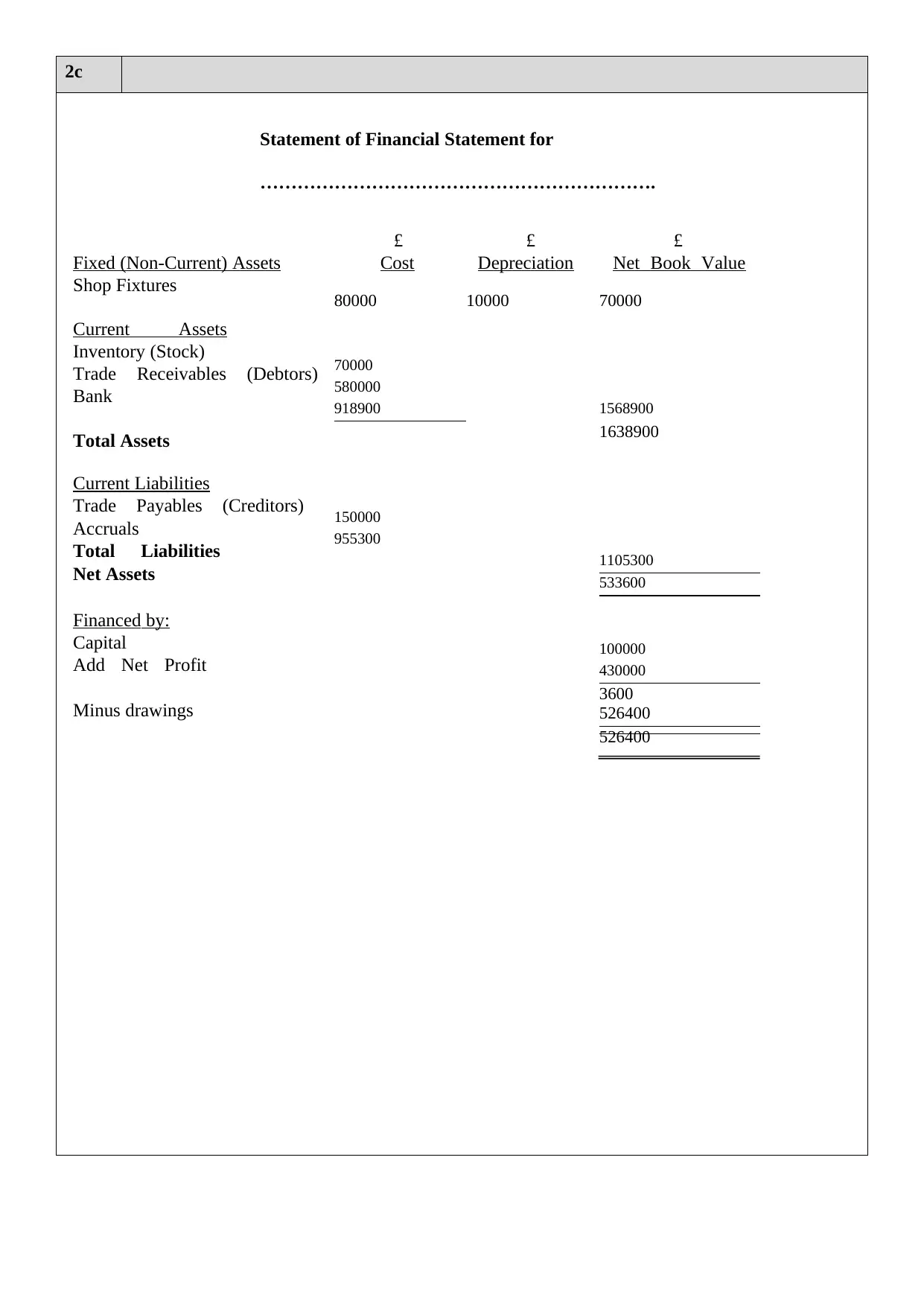
2c
Statement of Financial Statement for
……………………………………………………….
£ £ £
Fixed (Non-Current) Assets Cost Depreciation Net Book Value
Shop Fixtures
Current Assets
Inventory (Stock)
Trade Receivables (Debtors)
Bank
Total Assets
Current Liabilities
Trade Payables (Creditors)
Accruals
Total Liabilities
Net Assets
Financed by:
Capital
Add Net Profit
Minus drawings
80000 10000 70000
70000
580000
918900 1568900
1638900
150000
955300
1105300
533600
100000
430000
3600
526400
526400
Statement of Financial Statement for
……………………………………………………….
£ £ £
Fixed (Non-Current) Assets Cost Depreciation Net Book Value
Shop Fixtures
Current Assets
Inventory (Stock)
Trade Receivables (Debtors)
Bank
Total Assets
Current Liabilities
Trade Payables (Creditors)
Accruals
Total Liabilities
Net Assets
Financed by:
Capital
Add Net Profit
Minus drawings
80000 10000 70000
70000
580000
918900 1568900
1638900
150000
955300
1105300
533600
100000
430000
3600
526400
526400
Paraphrase This Document
Need a fresh take? Get an instant paraphrase of this document with our AI Paraphraser
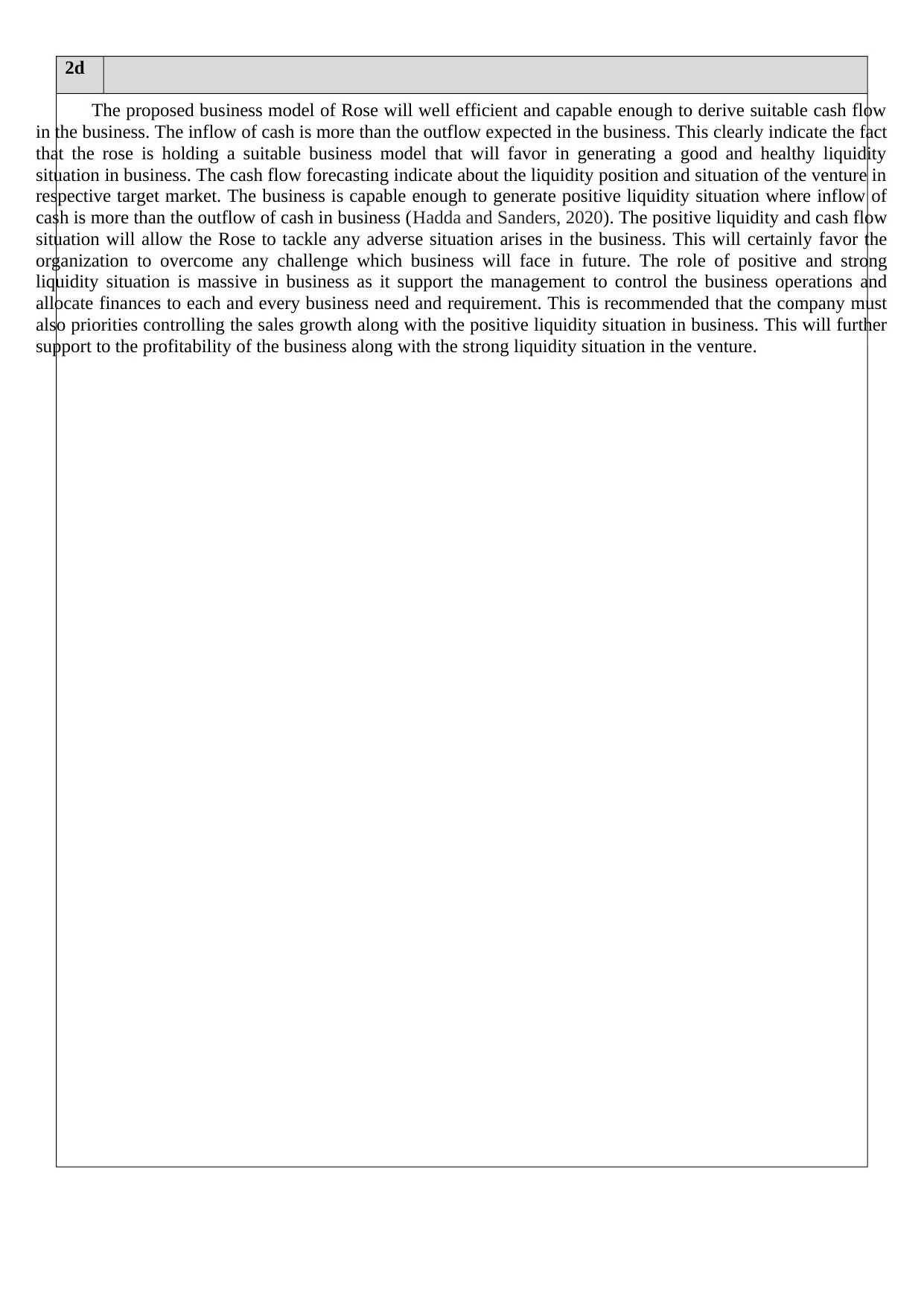
2d
The proposed business model of Rose will well efficient and capable enough to derive suitable cash flow
in the business. The inflow of cash is more than the outflow expected in the business. This clearly indicate the fact
that the rose is holding a suitable business model that will favor in generating a good and healthy liquidity
situation in business. The cash flow forecasting indicate about the liquidity position and situation of the venture in
respective target market. The business is capable enough to generate positive liquidity situation where inflow of
cash is more than the outflow of cash in business (Hadda and Sanders, 2020). The positive liquidity and cash flow
situation will allow the Rose to tackle any adverse situation arises in the business. This will certainly favor the
organization to overcome any challenge which business will face in future. The role of positive and strong
liquidity situation is massive in business as it support the management to control the business operations and
allocate finances to each and every business need and requirement. This is recommended that the company must
also priorities controlling the sales growth along with the positive liquidity situation in business. This will further
support to the profitability of the business along with the strong liquidity situation in the venture.
The proposed business model of Rose will well efficient and capable enough to derive suitable cash flow
in the business. The inflow of cash is more than the outflow expected in the business. This clearly indicate the fact
that the rose is holding a suitable business model that will favor in generating a good and healthy liquidity
situation in business. The cash flow forecasting indicate about the liquidity position and situation of the venture in
respective target market. The business is capable enough to generate positive liquidity situation where inflow of
cash is more than the outflow of cash in business (Hadda and Sanders, 2020). The positive liquidity and cash flow
situation will allow the Rose to tackle any adverse situation arises in the business. This will certainly favor the
organization to overcome any challenge which business will face in future. The role of positive and strong
liquidity situation is massive in business as it support the management to control the business operations and
allocate finances to each and every business need and requirement. This is recommended that the company must
also priorities controlling the sales growth along with the positive liquidity situation in business. This will further
support to the profitability of the business along with the strong liquidity situation in the venture.
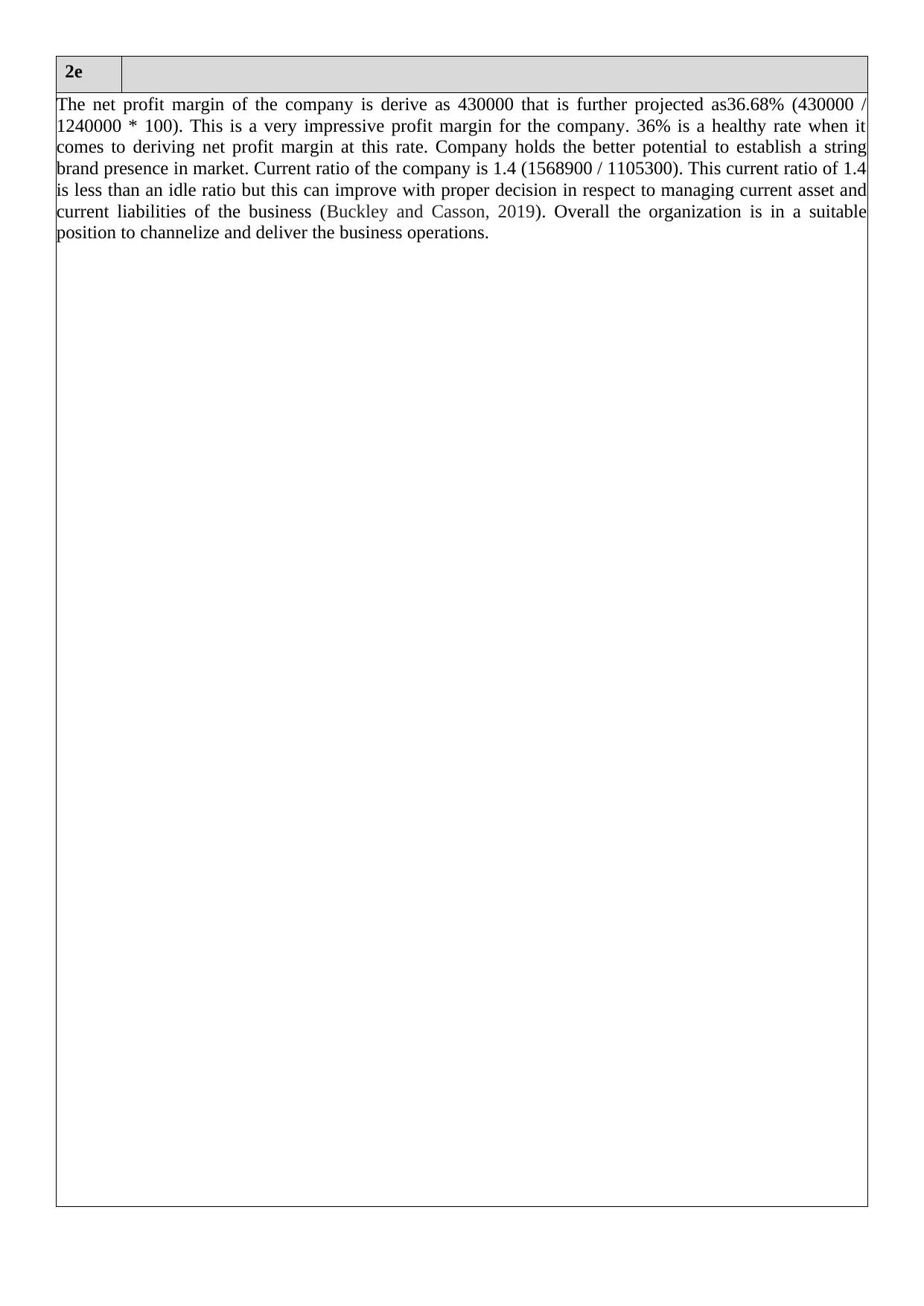
2e
The net profit margin of the company is derive as 430000 that is further projected as36.68% (430000 /
1240000 * 100). This is a very impressive profit margin for the company. 36% is a healthy rate when it
comes to deriving net profit margin at this rate. Company holds the better potential to establish a string
brand presence in market. Current ratio of the company is 1.4 (1568900 / 1105300). This current ratio of 1.4
is less than an idle ratio but this can improve with proper decision in respect to managing current asset and
current liabilities of the business (Buckley and Casson, 2019). Overall the organization is in a suitable
position to channelize and deliver the business operations.
The net profit margin of the company is derive as 430000 that is further projected as36.68% (430000 /
1240000 * 100). This is a very impressive profit margin for the company. 36% is a healthy rate when it
comes to deriving net profit margin at this rate. Company holds the better potential to establish a string
brand presence in market. Current ratio of the company is 1.4 (1568900 / 1105300). This current ratio of 1.4
is less than an idle ratio but this can improve with proper decision in respect to managing current asset and
current liabilities of the business (Buckley and Casson, 2019). Overall the organization is in a suitable
position to channelize and deliver the business operations.
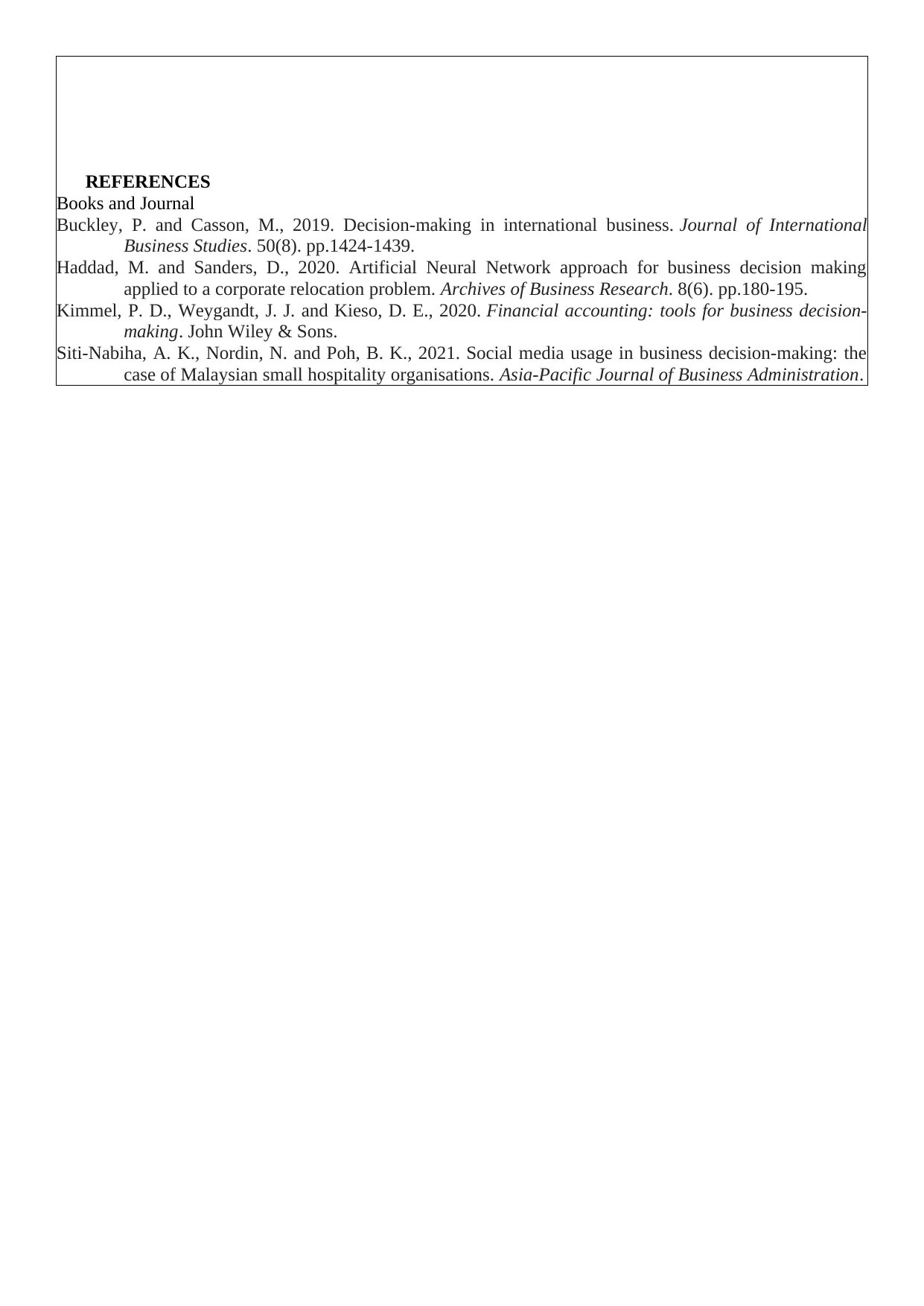
REFERENCES
Books and Journal
Buckley, P. and Casson, M., 2019. Decision-making in international business. Journal of International
Business Studies. 50(8). pp.1424-1439.
Haddad, M. and Sanders, D., 2020. Artificial Neural Network approach for business decision making
applied to a corporate relocation problem. Archives of Business Research. 8(6). pp.180-195.
Kimmel, P. D., Weygandt, J. J. and Kieso, D. E., 2020. Financial accounting: tools for business decision-
making. John Wiley & Sons.
Siti-Nabiha, A. K., Nordin, N. and Poh, B. K., 2021. Social media usage in business decision-making: the
case of Malaysian small hospitality organisations. Asia-Pacific Journal of Business Administration.
Books and Journal
Buckley, P. and Casson, M., 2019. Decision-making in international business. Journal of International
Business Studies. 50(8). pp.1424-1439.
Haddad, M. and Sanders, D., 2020. Artificial Neural Network approach for business decision making
applied to a corporate relocation problem. Archives of Business Research. 8(6). pp.180-195.
Kimmel, P. D., Weygandt, J. J. and Kieso, D. E., 2020. Financial accounting: tools for business decision-
making. John Wiley & Sons.
Siti-Nabiha, A. K., Nordin, N. and Poh, B. K., 2021. Social media usage in business decision-making: the
case of Malaysian small hospitality organisations. Asia-Pacific Journal of Business Administration.
1 out of 10
Related Documents
Your All-in-One AI-Powered Toolkit for Academic Success.
+13062052269
info@desklib.com
Available 24*7 on WhatsApp / Email
![[object Object]](/_next/static/media/star-bottom.7253800d.svg)
Unlock your academic potential
© 2024 | Zucol Services PVT LTD | All rights reserved.




